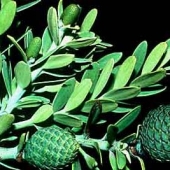Please select root levels for the menu
NZ Plants
Halocarpus bidwilli - bog pine, mountain pine
Podocarp family: Podocarpaceae
-
Mature foliage
I MacDonald
View picture -
Mature foliage, branches with leaves
I MacDonald
View picture -
Mature foliage, leaf detail
L Jensen
View picture -
Juvenile foliage
I MacDonald
View picture -
Juvenile stem giving rise to adult foliage
L Jensen
View picture -
Juvenile and adult foliage
L Jensen
View picture -
Juvenile foliage (left to right): H. bidwillii, H. biformis and H. kirkii
I MacDonald
View picture -
Pollen cones
J Braggins
View picture -
Immature seed cone
L Jensen
View picture -
Mature seed cone with fleshy aril
J Braggins
View picture
Halocarpus bidwilli is a slow growing many-branched shrub. Juvenile plants have needle-like leaves which pass abruptly into overlapping deep green scale-like leaves which lack a prominent ridge (keel). Small, fleshy ovule cones are formed in which the ovule is inverted and covered with both an inner integument and an outer epimatium (derived from the seed scale). After fertilisation an outgrowth of the epimatium expands to form a fleshy aril below the seed. Formerly known as Dacrydium bidwillii.
An endemic genus with three species. H. Bidwillii is found in moist to dry stony areas from the central North Island Volcanic Plateau to the South Island. Named after the English botanist and explorer, John Carne Bidwill (1815-1853), a collector of plants in New Zealand and Australia.
Vegetative characteristics |
Reproductive characteristics |
|---|---|
Adult plant form: shrub up to 3.5 m |
Pollen and ovule cones: on separate plants |
Adult leaf form: scale-like with no ridge (keel) on lower (outer) surface |
Pollen cone: terminal on stems, 3-5 mm long |
Adult leaf size: 1-2 mm |
Ovule cone: 3-5 mm long, of 1-2 fertile scales and 1-2 sterile bracts |
Adult leaf arrangement: singly along stem, flattened (appressed) to stem and closely overlapping |
Ovule position: on upper surface of fertile scale |
Juvenile leaf form: linear, stiff but not prickly |
Ovule coverings: an inner covering (integument); a black outer covering (epimatium) |
Juvenile leaf size: 5-10 mm |
Ovule pore (micropyle): directed downward |
Juvenile leaf arrangement: spiral, spreading away from stem |
Mature seed cone: consists of 1-2 ribbed black seeds, each with a white fleshy basal outgrowth of the epimatium |
Stem(receptacle) below seed: not fleshy with 1-2 bracts below the seed resembling the scale leaves |




